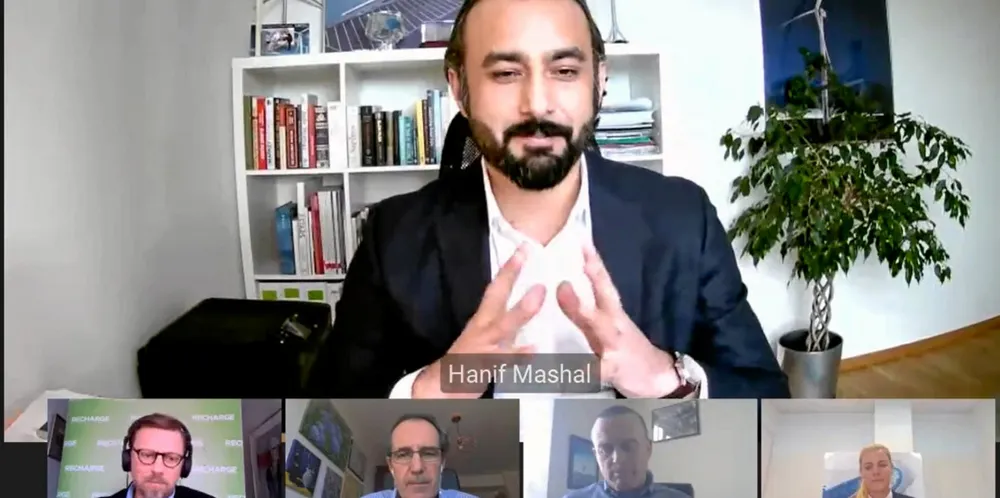Rivals must bridge-build to take wind 'last mile' to global energy leadership
Collaboration vital if sector is to make final leaps on cost reduction and sustainability, Recharge panel agrees

Green is the new black. Subscribe to Accelerate
Get the market insight you need into the global oil & gas industry's energy transition – from the new newsletter from Upstream and Recharge. Sign up here
Taking the global benchmark for wind’s levelised cost of energy (LCOE) from around $55/MWh today to under $20/MWh – and so below ‘brown’ rivals such as gas and coal – is a crucial step for wind but also “a big ask”, said Snieckus.
Revisit boundaries
Jorge Magalhães, onshore technology chief at wind OEM giant Siemens Gamesa, said to make new leaps the industry's leading players may have to “revisit the boundaries” of their intellectual property (IP) – even though he acknowledged the process would be “difficult”.
Magalhães said that as well as fields in which individual commercial interests would remain paramount, “there are areas that frankly probably don’t add that much differentiation, and our customers don’t care, and we [should] just industrialise the hell out of it”.
The Siemens Gamesa executive said the industry was currently “scratching the surface” of collaboration.
“We have forums where we have those discussions. I think they need to be accelerated and focused on more,” said Magalhães, who singled out joint industry projects (JIPs) – where various stakeholders work together to solve a mutual problem – as an example.
“More of that is needed. It isn’t aggressive enough. We may be coming to point in the maturity of the industry… where we may be able to accelerate those.”
'The turbine of today won’t look anything like the turbine of 2050'
The four industry executives on the Recharge panel were asked to name the technologies or trends that would have the biggest disruptive impacts on the wind industry in the next five to 10 years.
Jorge Magalhães, SGRE: “Digitalisation and modelling is the area that will give us the largest amount of change and opportunity – our ability to… validate everything digitally before we build a specimen, to represent the physical world in a digital environment.”
Hanif Mashal, LM Wind Power: “Materials, materials, materials! Materials that can give the same performance [more sustainably], allow advanced manufacturing approaches and can be reused. We can’t take a big bite out of our planet for every wind farm.”
Anne Vedel, Vestas: “Customers are looking into power plants that might have a different need [at different stages of their lifecycles]. A huge enabler for this is modularisation.”
Tony Quinn, ORE Catapult: “The future lies in testing, testing and more testing – to encompass digitisation and materials and gain customer and investor confidence. There will be huge innovation in next 20-30 years as we drive to net zero. The turbine of today won’t look anything like the turbine of 2050. Perhaps it won’t even be a three-blade horizontal axis wind turbine.”
Tony Quinn, test and validation director at the UK’s Offshore Renewable Energy (ORE) Catapult, agreed with Magalhães’ assessment of the questions OEMs and their main suppliers may need to begin asking.
“Where do the manufacture see their specific IP, and where are the [issues] we can solve for the mutual benefit of the industry? And how do we come together?
“I’m a big fan of JIPs. It’s absolutely necessary that we have that industry pull-through,” said Quinn.
On the wider issue of cost-reduction, Quinn said organisations such as ORE Catapult – currently testing giant components for GE Renewable Energy’s top-of-the-line Haliade-X offshore machine – would play a key role in “proving reliability as quickly as possible – that’s what the industry needs, that’s what investors need”.
Anne Vedel, senior vice president for product solutions and integration at Vestas Power Solutions, said the industry needs to factor-in customer requirements for years down the road, not just at the point of initial commissioning, as it develops its products.
“Five to 10 years down the line [the value of the energy produced] may be different when you don’t have your PPA [power purchase agreement] any more. The dynamics change over the lifetime of the power plant.”
Vedel claimed Vestas’ focus on modular architectures, as developed via its EnVentus turbine concept, will help customers remain adaptable and flexible, as well as enabling the benefits of industrialisation and helping the sector “speed up learnings and scale-up opportunities”.
Sustainability challenge
“If we want to be truly sustainable, a player in the sustainable energy space, we need to look at ourselves,” said Vedel.
Hanif Mashal, vice president for engineering at GE-owned blade specialist LM Wind Power, told the event’s audience that sustainability was a prime example of where the industry may be able to collaborate.
While some IP boundaries will remain, “there is a massive opportunity for collaboration… that benefits everybody”, said Mashal, citing manufacturing and quality assurance as two potential areas that could yield results, pointing to the high level of waste generated in blade production processes.
Philip Totaro, chief executive of research and consulting firm IntelStor, said collaboration and transparency will increasingly be crucial issues for the sector as it looks to “get that last mile” in cost reduction and competitiveness.
While advances in digitalisation had opened up huge opportunities for the sector, the industry “hasn’t necessarily made the results of a lot of that available to potential investors.
“The lack access to some of that data is one of the things holding up [progress],” claimed Totaro.
“People can go online and do comparison shopping for a mobile phone or a laptop, but they can’t do it for a wind turbine.”
- If you missed the Next-Gen Wind Turbine Technology event, a link to the replay is available here. Articles covering previous Recharge digital roundtables are below.